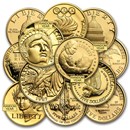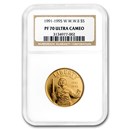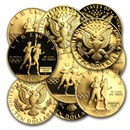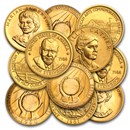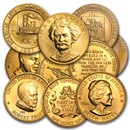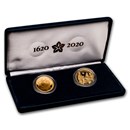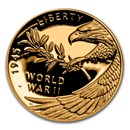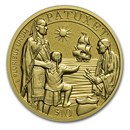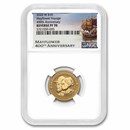Modern U.S. Gold Commemorative Coins

2016-W 1/4 oz Gold Standing Liberty Quarter SP-69 PCGS (FS)
$908.55

| Grade | Mintage | Population |
|---|---|---|
| 91,752 | 546 |

2016-W 1/2 oz Gold Walking Liberty Half Dollar SP-70 NGC
$1,749.00

| Grade | Mintage | Population |
|---|---|---|
| 64,451 | 8,052 |

2016-W 1/10 oz Gold Mercury Dime SP-70 NGC (Buchanan)
$509.00

| Grade | Mintage | Population |
|---|---|---|
| 124,885 | 24,887 |

2016-W 1/4 oz Gold Standing Liberty Quarter SP-70 NGC (ER/FR)
$895.00

| Grade | Mintage | Population |
|---|---|---|
| 90,375 | 10,021 |

2016-W 1/2 oz AG Walking Liberty Half Dollar SP-70 NGC (Buchanan)
$1,995.00

| Grade | Mintage | Population |
|---|---|---|
| 64,451 | 8,052 |

2016-W Gold Walking Liberty Half SP-70 PCGS (FS,Centennial Label)
$1,849.00

| Grade | Mintage | Population |
|---|---|---|
| 3,900,600 | 2,197 |

2016-W Gold Standing Liberty Quarter SP-70 PCGS (FS, Flag Label)
$895.00

| Grade | Mintage | Population |
|---|---|---|
| 1,952,000 | 3,558 |

2016-W 1/10 oz Gold Mercury Dime SP-70 PCGS (FS, Gold Foil)
$549.99

| Grade | Mintage | Population |
|---|---|---|
| 124,885 | 2,044 |

2002-W Gold $5 Commem Olympic Winter Games PR-69 PCGS
$584.63

| Grade | Mintage | Population |
|---|---|---|
| PR-69 | 227,131 | 1,672 |
Sale

2001-W Gold $5 Commem Capitol Visitor Center MS-69 PCGS
$594.63
$604.63

| Grade | Mintage | Population |
|---|---|---|
| MS-69 | 6,761 | 2,961 |

2000-W $10 Commem Library of Congress MS-70 NGC (Everhart)
$2,995.00

| Grade | Mintage | Population |
|---|---|---|
| N/A | 1,376 |

2000-W Gold/Platinum $10 Commem Library of Congress PF-69 NGC
$895.00

| Grade | Mintage | Population |
|---|---|---|
| PF-69 UCAM | 27,445 | 2,760 |

2000-W Gold/Platinum $10 Commem Library of Congress PR-70 PCGS
$1,269.00

| Grade | Mintage | Population |
|---|---|---|
| PR-70 DCAM | 27,445 | 745 |

1996-W Gold $5 Commem Cauldron PF-70 NGC
$664.64

| Grade | Mintage | Population |
|---|---|---|
| PF-70 Ultra Cameo | 38,555 | 636 |

1995-W Gold $5 Commem Olympic Torch Runner PR-69 PCGS
$594.63

| Grade | Mintage | Population |
|---|---|---|
| PR-69 | 57,442 | 2,710 |

1995-W Gold $5 Commem Olympic Stadium PF-70 NGC
$664.64

| Grade | Mintage | Population |
|---|---|---|
| PF-70 UCAM | 43,124 | 708 |
About U.S. $5 Commemorative Gold Coins
Modern U.S. $5 gold commemorative coins are a series of commemorative coins issued by the United States Mint from 1986 to 2021. These coins were authorized under various acts of Congress and were minted in limited quantities to commemorate significant people, places, or events in American history.The $5 denomination was chosen because it was used for many historic U.S. gold coins. Each coin contains 90% gold and 10% copper and has a diameter of 21.6 millimeters and a weight of 8.359 grams.
Some notable $5 gold commemorative coins include the 1986 Statue of Liberty centennial coin, which was issued to commemorate the 100th anniversary of the dedication of the Statue of Liberty; the 1996 Atlanta Olympic Games coin, which was issued to celebrate the 1996 Olympic Games held in Atlanta, Georgia; and the 2014 National Baseball Hall of Fame coin, which was issued to commemorate the 75th anniversary of the National Baseball Hall of Fame and Museum.
The designs of these coins vary widely, with many featuring famous people or landmarks. Each coin's obverse (front) features a portrait or depiction of the person, place, or event being commemorated. In contrast, the reverse (back) typically features a design related to the coin's theme.
Modern U.S. $5 gold commemorative coins are highly collectible and are often sought after by coin collectors and investors. Their limited mintage and historical significance make them a unique and valuable addition to any collection.
Investors and collectors interested in purchasing American gold coinage at a lower price point may want to consider fractional options. Beloved series such as the Gold Eagles come in a 1/10 oz size, making it a more affordable entry point than 1 oz historical coins.
Benefits Of Using Boxes & Capsules When Storing Coins
There are several benefits to using capsules and boxes for coins, including:
- Protection: Capsules and boxes protect from scratches, abrasions, and other damage that can occur during storage or transportation. Coins are delicate objects that can be easily damaged, and encapsulating or boxing them helps to keep them in pristine condition.
- Preservation: Capsules and boxes also help to preserve the condition of coins over time by shielding them from environmental factors such as moisture, dust, and light. This is particularly important for coins made from precious metals, as these can tarnish or corrode if exposed to air or other contaminants.
- Organization: Using capsules and boxes can also help keep your coin collection organized and easily managed. Boxes can be labeled and sorted according to denomination, date, or other criteria, while capsules can be easily stacked or arranged in trays or drawers.
- Display: Capsules and boxes can also be used for display purposes, allowing you to showcase your coins safely and attractively. Many packages and capsules are designed to be clear or transparent, allowing you to view the coins without handling them.
History Of The U.S. Mint
The United States Mint is one of the oldest federal agencies in the United States, with a history that dates back to the country's founding. The Mint was established by Congress in 1792 under the Coinage Act, which authorized the production of coins to be used as currency in the new nation.The Mint's first facility was established in Philadelphia, Pennsylvania, and it was tasked with producing gold, silver, and copper coins for circulation. In its early years, the Mint faced many challenges, including a shortage of raw materials, technical difficulties with coin production, and the need to establish uniform standards for coinage.
Despite these challenges, the Mint expanded rapidly during the 19th century, with new facilities opening in Charlotte, North Carolina; Dahlonega, Georgia; New Orleans, Louisiana; Denver, Colorado; and San Francisco, California. The Mint also played a crucial role in supporting the Union during the Civil War, producing millions of dollars worth of coins and medals to help finance the war effort.
In the 20th century, the Mint continued to evolve, adapting to new technologies and changing demands for currency. The Mint began producing commemorative coins in the 1930s, and in the 1970s, it introduced the Eisenhower dollar and the Susan B. Anthony dollar. The Mint also played a crucial role in developing the modern commemorative coin program, which began in 1982.
Today, the United States Mint is responsible for producing circulating, commemorative, and bullion coins, as well as providing numismatic products and services to collectors and investors. The Mint operates facilities in Philadelphia, Denver, San Francisco, and West Point, New York, and continues to be one of the most important institutions in American financial and cultural history.
Check out what other customers are saying.

